It was dawn in mid-February 2022 when I stepped outside to check the weather. Snow was on the ground, but the roads were clear. The temperature was just above 40 degrees and expected to rise slightly throughout the day. Perfect for the 50-mile run I was about to attempt.
I put on my red calf sleeves, black running shorts, and navy long-sleeve top. Standing in front of my suburban house, I reached out to touch my mailbox like it was my personal starting line, and paused. Wait, what, why?
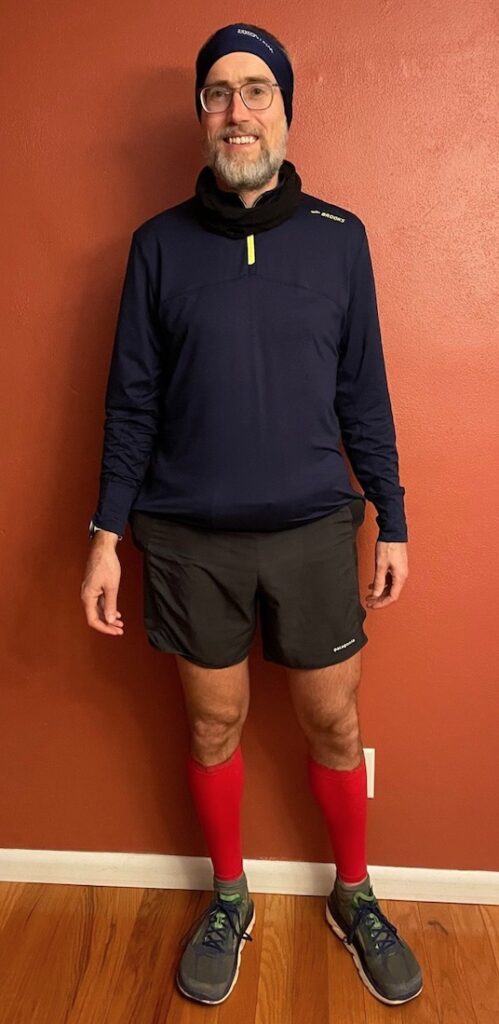
Stosberg, ready to run 50 miles. | Courtesy photo
These very long runs give me a lot of time to think, for better and worse. Today, after leaving at dawn, I expected to return about dusk if things went well, or earlier if I needed to bail out.
I thought about how I got to this place, a story stretching back to nine years earlier.
Mountain run
The first long run I remember was from the top of a mountain in Vermont. I’d been stuck in a cabin all day on a computer and decided to jog down the road to explore.
Running felt easy enough, and I soon found out why. I’d just been pleasantly jogging down the mountain for four miles. As I turned to face where I’d come from and looked up, up, up the mountain, I realized what I’d gotten myself into.
My return to the cabin was at a much slower pace than my downhill journey. I arrived depleted but with a sense of accomplishment. Glowing with both pride and lack of experience, I thought, Since this is the first time in my life I’ve run eight miles, then I’m better prepared than ever to run the half-marathon distance of 13.1 miles, right?!
Before I ran, I biked on country roads in Indiana. I appreciated the wildlife and the time outdoors during both pursuits. While I didn’t go as far, running required only a pair of sneakers and took me to even more remote trails than a bike could. I liked that. So I kept running.
Some weeks after that fateful run at age 38, I happened upon the book Finding Ultra. Rich Roll described his unhappiness and poor health at middle age. After difficulty walking up a staircase, he decided something had to change. He replaced alcohol and fast food with endurance sports and a vegan diet. My own belt didn’t tighten as far as it used to, and my back still hurt from a previous sciatica episode. I experienced pain so bad in my lower back and down my legs that lying on my back was the only comfortable position for two weeks. The first week I took off work, while the second one I rigged up a laptop and keyboard to work from a completely horizontal position. I didn’t know how yet, but I resolved to get better and be better at warning signs to not get so out of balance in the future. Like Roll, I also needed to change. He was right: He was too young to feel old. Maybe it wasn’t too late to become a healthier athlete.
Daydreaming and memories
My first mile of daydreaming was interrupted when I turned right onto the 45/46 Bypass and spotted another runner across the street. Luke Fowler. He’s got this efficient gait that looks effortless, yet he’s moving quickly.
I’m reminded I don’t need just to run slower to pace myself for such a long run; I need to run efficiently. I quicken my cadence but keep my effort low. There it is — the efficient but easy pace I hope will get me through this 50-mile day. I settle into that pace and return my thoughts to what got me there.
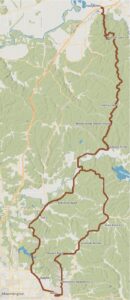
The 50-mile route between Bloomington and Martinsville.
I didn’t play sports in high school or college. Instead, I went skateboarding. A lot.
The result of all that skateboarding during my formative years was that one of my calf muscles became much larger than the other — the leg that pushes while the other leg stays on the skateboard. More than twenty years later, there’s still a visible difference in size.
So when I started running, I had the gait of a wounded gorilla. At 6’4”, I’d lunge forward with my shorter and heavier left leg, then try again on the right side with my lighter and longer leg, all the while wondering if I could fully inflate my lungs.
But yet, bodies are magical, and mine had a way of keeping me upright when I ran and not collapsing to catch my breath.
A runner’s low
I had recently moved to Bloomington, Indiana, when I started running. I hadn’t met many other folks that first year who run. But the lack of good advice didn’t stop me from what I viewed as the best chance in my life to attempt the half-marathon distance, building on the “success” of my mountain run where I had no choice but to climb back up the mountain to get home.
As a nod to that run, I designed a scenic route that also was flat or downhill for the first half, then spent the second half climbing up a big hill, and generally continuing uphill for the rest of the second half. Bloomingtonians know this as the Swartz Ridge–Moore’s Creek loop.
Planning a route that got harder, not easier, in the second half was one of many things that went wrong on that 13.1-mile run. Really, it was a failure by just about every measure. That was clear by mile 11 when I stopped by the side of the road to catch my breath and take stock. I could feel the blisters in my shoes. Crotch chafing was setting in. I’d thrown modesty to the wind and taken off my shirt because the nipple chafing wasn’t far behind. My water bottle was empty, my snacks were gone, the mid-day sun was starting to cook me and my legs felt like jelly. The last two miles seemed to stretch on for an hour, made worse by a poor route choice on a busy road. Arriving home, I steadied myself on the porch railing before weakly opening the door. I tried to talk but grunt-whispers came out. Water. Food. Shower. Bed.
Ignoring the data
Speaking of problems, my attention was pulled back to my 50-mile run, where I drifted along to mile eight.
My running had improved in some respects from that first 13-mile run, but I was not immune to the classic runner problem: Sometimes I go out too fast and suffer later. I had improved my pacing on my long runs, but the stakes were higher today. Too much effort early on could leave me fatigued at the end of this, and I might need to bail on the project.
So when I turned from Old 37 to the massive hill on Robinson Road, my mind was on my heart rate. I thought I had my effort under control, but my Garmin watch disagreed. It registered my heart rate going out of the Easy Zone. I slowed my effort, but my heart rate didn’t seem to be falling. There were a lot of hills and this was not a good sign. It still had not recovered when the road flattened out. Gah. I started to walk some to let my heart rate recover.
But then I thought, Wow, I’m already walking on some flats. This is going to be an extremely long day if I’m walking up the hills and on the flats. It was at that point I decided the worrying wasn’t helping. I wasn’t out there to obsess about a watch. From there on, I would try to ignore the heart data on my watch and control my effort by intuition.
Better planning
I thought back to how I reacted to all the problems from my first 13-mile run. Sure, I thought about quitting then, or at least returning to shorter, easier, chafe-free runs. But other intrusive thoughts crept in. Thoughts about how to prevent blisters with different shoes and socks. Discovering Body Glide to prevent chafing. Better route planning. Cooler temperatures. A water bottle. Better snacks.
Sometimes I found conventional solutions. Conventional, like every runner knows to tape their nipples on long runs so they don’t bleed from chafing, right? It’s not something we talk about.
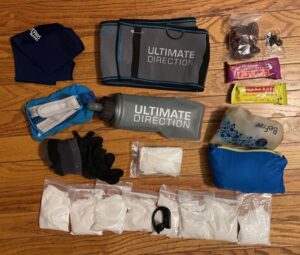
The gear Stosberg took on his 50-miler included a waist belt, water filter, snacks, and energy drink mix.
Other solutions were less conventional. On this 50-mile, all-day run, I was carrying everything I needed in a tall mesh belt with four pockets that go all the way around. My running shorts had another five pockets. Water is relatively heavy, so instead of carrying a lot of it, I plan the routes and dates of my long runs to incorporate refilling my water bottle along the way from streams or lakes. On this day I carried a small water filter for that purpose.
I didn’t need to drink as much today, thanks to the temperatures, and stopped at a favorite filter stop about 17 miles in, just before I entered Morgan-Monroe State Forest. The ideal filter spots are small streams just a few steps off the route. I arrive with the BeFree flask already open and in my hand. With two quick scoops of water, I can be running again in 30 seconds. Holding and squeezing the flask with my left hand, I can filter water into my water bottle as I run.
After increasing my range to 13 miles, I entered a cycle of creating incrementally harder challenges for myself, with runs of 16, 19, 22, 26, then 31 miles. A run from Bloomington to Nashville for lunch and then back was 37 miles.
As I kept running, I lost weight, got faster, learned how to fail less, and followed Rich Roll toward the path of cutting out the remaining animal products from my diet, little by little.
But this wasn’t just an exercise in making a mileage number go up. On this day, it was important that I really understood why I was out there. Even though I had run 37 miles in the past, why extend that by almost the distance of another half marathon? This wasn’t a morning run anymore. I’d be gone from my family and the rest of my life all day.
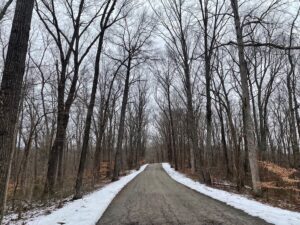
The climb on the road into Morgan-Monroe State Forest, where the route would change from clear road to snowy trails.
Changing trail conditions
The big climb on the road into Morgan-Monroe pulled me back into the present.
I noticed there was still snow on the north side of the hills, while it was melting on the south side. This difference had a noticeable impact on the temperature.
Details like that keep running the same routes fresh year around. The same route in different weather is a new route.
As I tuned into the environment, I noticed that the snow on the ground wasn’t the same depth on the ground as when I left my house. It was getting deeper. It hadn’t occurred to me that there might be more snow farther north.
My route switched from cleared roads to snow-covered trails, and I entered slushy, sometimes slick, packed pathways. I was irrationally excited to be entering what was objectively the most dangerous part of the run: snowy trails, new routes, and little cell service.
Soon I arrived at the first lake I planned to filter water and refill my bottle, only to discover my next winter challenge: The lake was frozen. Because the air temperature was several degrees above freezing, I honestly hadn’t prepared for this. Yet, I found the lake had thawed in just a small area where I needed to filter water. Perfect!
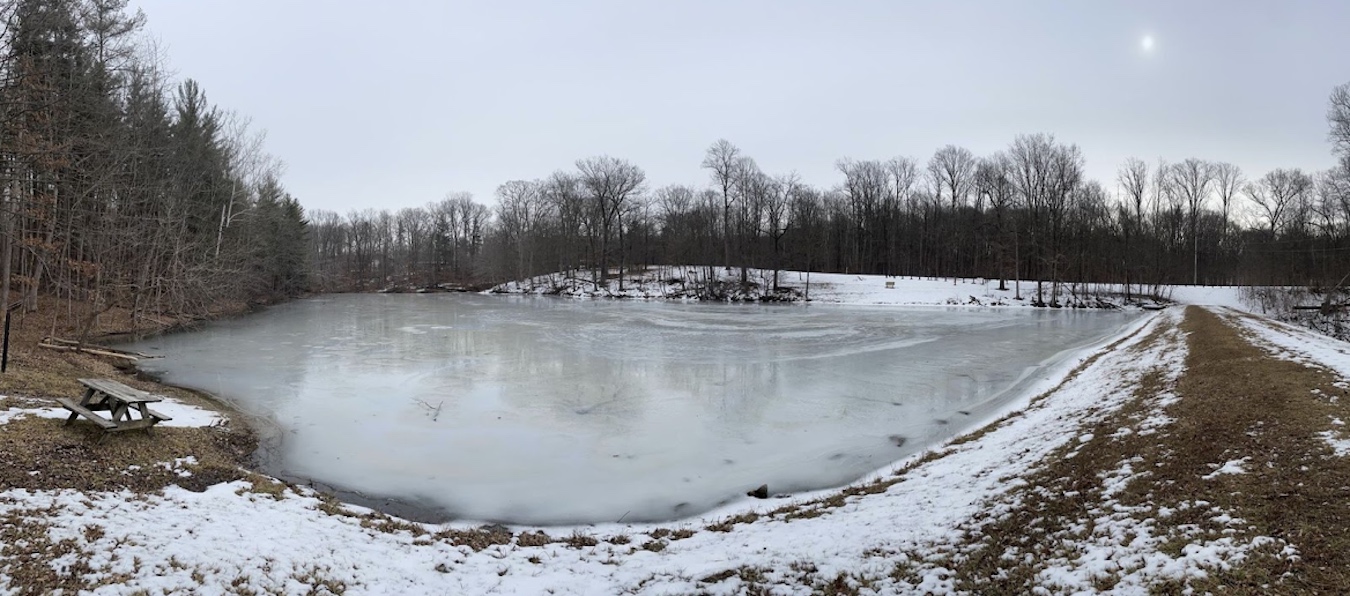
Stosberg had planned to filter water at this small lake, but it was mostly frozen. He found a spot thawed just enough to get some water.
The air temperature around the lake reflected the mass of ice there. That inspired me to keep my visit short and keep moving.
So far, I was on familiar trails, but now they were transformed by snow. This made for a rewarding experience, if dicey. Since most of my run was on roads, I decided to wear road shoes for this adventure, so I didn’t have great traction in the snow.

On long runs, Stosberg filters water from streams and lakes along the route so he doesn’t have to carry as much.
As I moved toward the north end of the forest, it was time to turn on the trails that I’d seen only on maps. I was relying on the offline maps on my watch to help navigate. The first thing I noticed was that all the footprints from the popular part of the park were gone now. At least the human ones. Deer, raccoon, and coyote prints were clearly present.
Although more remote, this section was safer in one way: All those hiker footprints made for slicker trails, while I could blast down these powdery trails, adding the first prints.
I was looking forward to seeing Prather Lake for the first time. My map indicated that I should expect to find a trail along the southern shoreline, but when I got there, there was no trail. Also, the lake was frozen, and this time I didn’t see a place to filter water.
So now I’m about 24 miles in, I’ve been running for four hours or so, and things seem to be falling apart. I scrambled up a hill to find another way to get past the lake, as it’s too steep to go along the shore.
And just where I needed a trail to be, a mossy path appeared. After running for miles on snow-covered trails, running on this mossy green trail felt magical.
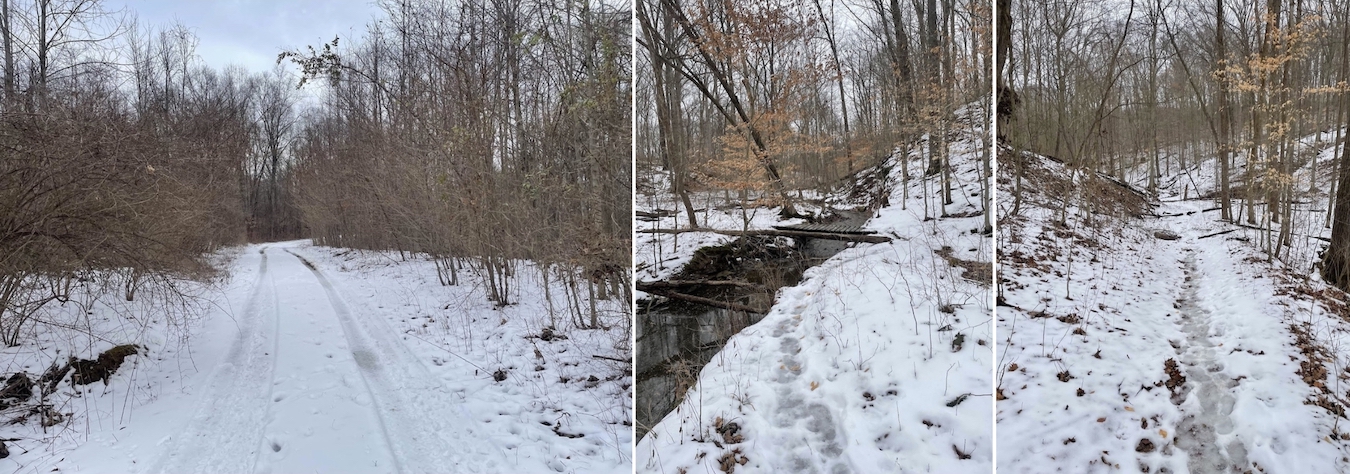
Running conditions can be different from one snowy trail to the next, which, Stosberg says, can make for “a rewarding experience, if dicey.”
As I ran along the mossy ridge, to my left was a steep hillside with some thin trees that went down to the frozen lake. It was so steep that if I started to fall, it seemed likely I’d roll down the lake before I caught myself.
And that’s when the trail gave way beneath me. With no time to react, I found myself sitting on the trail I’d just been running on, with my legs dangling down the hillside, just one butt-scoot away from sliding down the hill. Close call. Yet, somehow, no injuries. No scrapes, no pains. Yes, my risk assessment for my plan for the day did flash through my head.
The magical mossy trail connected with the next section of the route, and again the ice had thawed just enough for my filtering needs.
[Editor’s note: The Martinsville Conservation Club Easement that connects Prather Lake with Martinsville has since been closed for safety reasons, according to the website for the Knobstone Hiking Trail Association.]
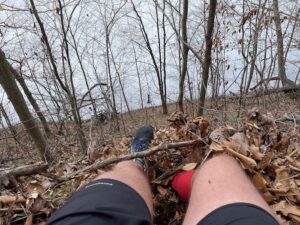
Stosberg had a close call when the trail gave way atop a steep hill, and he nearly tumbled down to the lake.
The next two miles went by quickly. The trail exited the woods by a gun range, I jogged for less than a mile on the road, and then I was there: CHINA BUFFET.
Eating a greasy buffet lunch sounds like a terrible idea. So despite the restaurant name, that’s not what I did. I avoided meat, oil, and fried foods and ordered a simple meal of tofu, veggies, and white rice. To that, I added three drinks: two hot Oolong teas and water.
I must have walked in there looking like I just had a bad day at the adult soccer league. Bless the hospitality workers who overlook the rough edges, and smells, of their guests.
As much as I enjoyed being warm and indoors again, I knew the urge to nap would set in if I rested much longer.
I paid my bill and headed back outside to reverse my course.
I felt an unexpected lightness as I got back on the trails. I had less than a marathon-distance left to go. The remaining miles felt familiar, possible. After having trained for longer and longer runs, I knew how to pace myself for what lay ahead. I set my pace a notch faster. I was still trying to be reserved and efficient, but a tad more assertive. I smiled. Maybe I could do this.
As I returned through the remote section of Morgan-Monroe Forest, it started to drizzle.
“
The same route in different weather is a new route.
”
I was out here on this particular day, a Friday in February, because the weather forecast was my idea of “perfect for running”: It stayed close to 45°F (7.2°C) all day. But the threat of rain that helped to stabilize the temperature throughout the day came with the possibility of actual rain.
The drizzle was turning into a light rain, and I was starting to get soaked.
At mile 34, I took a break from the rain at the Beanblossom shelter, where I treated myself to some dry toe socks to ward off blisters. The drizzle seemed poised to become something worse at any moment, and cell service was spotty. If the rain became harder and colder, it could lead to hypothermia. But now it was mild, and as long as I kept generating some warmth by running, I’d be warm enough. I thought.
I headed back out into the rain. Both my base layer and the windbreaker I had put on were wet now. But taken together, the windbreaker trapped just enough heat to stay comfortable, so I kept going. But why was I out here again?
An uncomfortable place
This was the time in the long run where I had to answer the question: Why keep going, when it would be easy to quit? It was ten miles until I could even refill my water again, my whole body was telling me it had already run plenty, and the weather had turned from ideal to potentially dangerous.
I was not racing. Hardly anyone knew what I had planned today. I was there for that moment: when I’ve run far enough and long enough that my brain shuts off and I’m simply running, just there. I was there because I value putting myself in an uncomfortable place. A challenge that is possible, but uncertain.
If this were an easy run, my body could do it on autopilot while I lived in my mind. On this day, the task at hand required my full attention to succeed. I needed to run with intention, to breathe with care. I needed to tune in to the environment and my own self-awareness and adjust throughout the run.
My day job is online — in my head, abstract. Lisa Miller’s book Awakened Brain added scientific explanations for what I had been learning intuitively. I had listened to the book to pass the time on some dark and cold winter training runs leading up to this. Time in nature is beneficial, and more is better. When our brains are in a meditative state, they emit alpha waves. These waves may play a role in suppressing distractions, in supporting internal focus and quiet awareness. The vibration of the planet itself, Schumann’s resonance, is an alpha wave. It is everywhere in nature but is disrupted by human activity like power lines, radios, and other electromagnetic noise. As someone who is extremely online, taking a day extremely offline brings vital balance and reconnection.
I was nudged into this habit by another book, Born to Run, by Christopher McDougall. Running is in the DNA of humans. We sweat, while animals we hunt could not. We used that to our advantage to chase them to exhaustion and overheating — a task that sometimes took all day and more than a marathon distance. Long-distance running wasn’t an extreme sport, it was just life. Today, I was tapping into that primal instinct, a belief that this was something I was capable of even if memories had been lost for generations.
Regular running prevents “undertraining” injuries: the return of back pain and physical stress that I’ve felt creeping back in when I’ve tried to stop for just a week or two. In a perhaps perverse way, ultra-long runs celebrate my newfound health with a goal that requires firing on all cylinders to complete.
At home, when climate change brings extreme heat and droughts, we can turn on the air-conditioning, and the tap water still flows.
On these long runs, I depend on natural water sources to drink from, just like deer and other animals do. Because of this habit, I’m tuned into the water levels in streams year-round. By checking the water level in a stream near my house, I can estimate with some accuracy if a small stream in a forest ten miles away will be dry or running.
When the streams go dry in a drought, I can take a break from long runs, but what about the other animals that depend on them with no air-conditioning or tap water?
To be out there, to be uncomfortable, to be connected, is grounding. It’s humbling. It informs the rest of my life, whether I’m called to be uncomfortable at work, or to make daily choices to impact climate change or how we share our environment with the animals who call it home.
So ready to be done …
Still, I have my limits on how long I can stay completely tuned in. After eight hours of running, I’d reached that point on this run. I’d had enough “being in the moment” and got my Bluetooth earbud to transport my head somewhere else as I ground out more miles. I felt I’d gotten what I needed out of the run. Now I just needed to keep going and get home.
The good news about the second half of my route is that it was slightly flatter. The bad news is that I was going to run on State Road 45 for some miles. It was now near “rush hour,” and I was no longer in top form. I resolved to try to run a little faster along 45, just to get that section done faster.
I had my mind set on Lakeside Market in New Unionville. This gas station and food mart was my last planned stop before home.
I arrived there so ready to be done. I considered calling my wife to come and get me. But in the time I might spend waiting and riding back, I could run most of the way home.
I surveyed the range of drinks in the drink fridge. So many options for a thirsty runner. The liquid calories of a Naked Juice seemed perfect. I bought one and quickly downed it. I felt better. Not great, but, I thought, OK, I could finish this. I hobbled toward the door and pointed my body toward the rolling hills of Russell Road.
Almost home
I had had in my head that the actual distance was going to turn out to be 48 miles. Which I was fine with. I would run to Martinsville and back. Good enough.
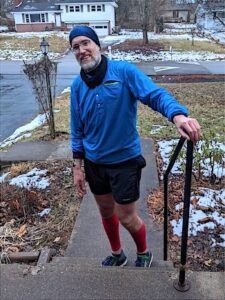
Adventure complete.
Despite fatigue, my legs were still carrying me up and over the rollers on Russell Road as the sun was setting. I was passing University Elementary and knew that I was a mile from home. My watch said 48.3 miles. Even in my fuzzy-brain state, I realized this meant that I was going to be within a mile of 50 miles.
And I mean, who stops a run at 49.3 miles, amirite? I hadn’t been paying attention to my average pace either, but I saw it was hovering just above 10 minutes per mile.
And that was the moment I found some resolve to dig a little deeper, finish strong and GET IT DONE. My pace went from low gear to high gear. This was happening. And then I did one of the hardest things on my run: I saw my house and turned left instead of going straight so I could get in that final half mile with another lap around a block.
Then, I was done. I did it. Adventure complete. I leaned on my porch railing for stability. This time, I smiled.



